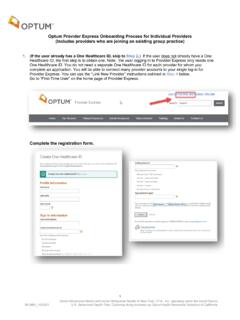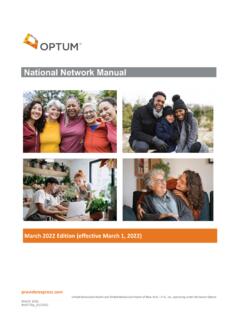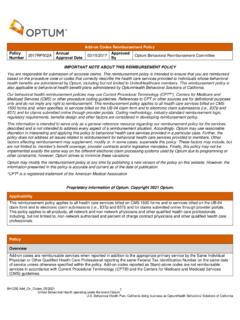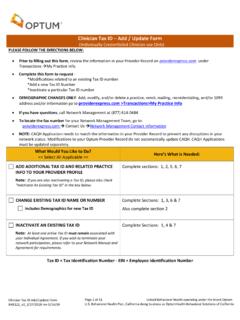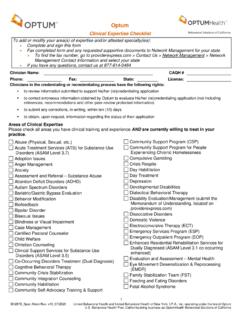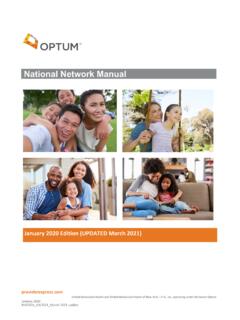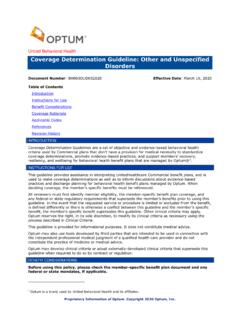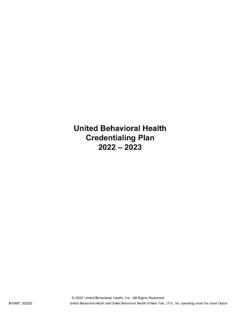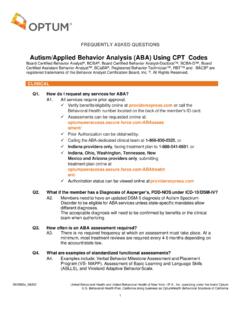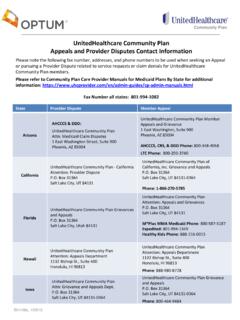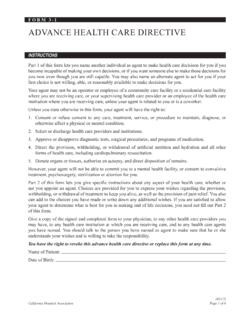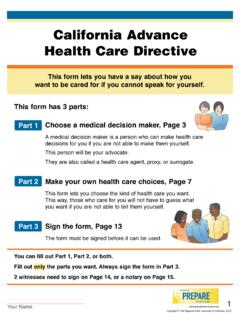Transcription of LEVEL OF CARE GUIDELINES: MENTAL HEALTH CONDITIONS
1 BH803 LOCGMH_022018 Page 1 of 14 LEVEL of care guidelines : MENTAL HEALTH CONDITIONS Effective February 2018 Proprietary Information of Optum. Copyright 2018 Optum, Inc. LEVEL OF care guidelines : MENTAL HEALTH CONDITIONS Guideline Number: BH803 LOCGMH_022018 Effective Date: February, 2018 Table of Contents PageINTRODUCTIONCOMMON ADMISSION CRITERIA FOR ALL LEVELS OF care COMMON CONTINUED SERVICE CRITERIA FOR ALL LEVELS OF care COMMON DISCHARGE CRITERIA FOR ALL LEVELS OF care COMMON CLINICAL BEST PRACTICES FOR ALL LEVELS OF care guidelines : OUTPATIENT guidelines : INTENSIVE-OUTPATIENT PROGRAM (IOP) guidelines : DAY TREATMENT PROGRAM guidelines : PARTIAL HOSPITAL PROGRAM (PHP) guidelines : RESIDENTIAL TREATMENT CENTER (RTC) guidelines : CRISIS STABILIZATION & ASSESSMENT guidelines : 23-HOUR OBSERVATION guidelines .
2 INPATIENT REFERENCES HISTORY/REVISION INFORMATION INTRODUCTION The LEVEL of care guidelines is a set of objective and evidence-based behavioral HEALTH criteria used by medical necessity plans to standardize coverage determinations, promote evidence-based practices, and support members recovery, resiliency, and wellbeing1 for behavioral HEALTH benefit plans that are managed by Optum and Behavioral HEALTH Plan, California (doing business as OptumHealth Behavioral Solutions of California ( Optum-CA )). The LEVEL of care guidelines is derived from generally accepted standards of behavioral HEALTH practice. These standards include guidelines and consensus statements produced by professional specialty societies, as well as guidance from governmental sources such as CMS National Coverage Determinations (NCDs) and Local Coverage Determinations (LCDs).
3 The LEVEL of care guidelines is also derived from input provided by clinical personnel, providers, profesisonal specialty societies, consumers, and regulators. For more information on guiding principles for the LEVEL of care guidelines and their development, approval, dissemination, and use, please see the Introduction to the LEVEL of care guidelines , available at: > Clinical Resources > LEVEL of care guidelines . Before using this guideline, please check the member s specific benefit plan requirements and any federal or state mandates, if applicable. 1 The terms recovery and resiliency are used throughout the LEVEL of care guidelines . SAMHSA defines recovery as a process of change through which individuals improve their HEALTH and wellness, live a self-directed life, and strive to reach their full potential.
4 SAMHSA defines resilience as the ability to adapt well over time to life-changing situations and stressful CONDITIONS . The American Society of Addiction Medicine defines recovery as a process of overcoming both physical and psychological dependence on a psychoactive substance, with a commitment to sobriety, and also refers to the overall goal of helping a patient to achieve overall HEALTH and well-being. OPTUM LEVEL OF care guidelines : MENTAL HEALTH CONDITIONS BH803 LOCGMH_022018 Page 2 of 14 LEVEL of care guidelines : MENTAL HEALTH CONDITIONS Effective February 2018 Proprietary Information of Optum. Copyright 2018 Optum, Inc. COMMON ADMISSION CRITERIA FOR ALL LEVELS OF care The member is eligible for benefits.
5 AND The member s condition and proposed service(s) are covered by the benefit plan. AND Service(s) are within the scope of the provider s professional training and licensure. AND The member s current condition cannot be safely, efficiently, and effectively assessed and/or treated in a less intensive LEVEL of care . o Failure of treatment in a less intensive LEVEL of care is not a prerequisite for authorizing coverage. AND The member s current condition can be safely, efficiently, and effectively assessed and/or treated in the proposed LEVEL of care . Assessment and/or treatment of the factors leading to admission require the intensity of services provided in the proposed LEVEL of care . AND Co-occurring behavioral HEALTH and medical CONDITIONS can be safely managed.
6 AND Service(s) are the following: o Consistent with generally accepted standards of clinical practice; o Consistent with services backed by credible research soundly demonstrating that the service(s) will have a measurable and beneficial HEALTH outcome, and are therefore not considered experimental; o Consistent with Optum s best practice guidelines ; o Clinically appropriate for the member s behavioral HEALTH CONDITIONS based on generally accepted standards of clinical practice and benchmarks. AND There is a reasonable expectation that service(s) will improve the member s presenting problems within a reasonable period of time. o Improvement of the member s condition is indicated by the reduction or control of the signs and symptoms that necessitated treatment in a LEVEL of care .
7 O Improvement in this context is measured by weighing the effectiveness of treatment against evidence that the member s signs and symptoms will deteriorate if treatment in the current LEVEL of care ends. Improvement must also be understood within the broader framework of the member s recovery, resiliency, and wellbeing. COMMON CONTINUED SERVICE CRITERIA FOR ALL LEVELS OF care The admission criteria continue to be met and active treatment is being provided. For treatment to be considered active , service(s) must be as follows: o Supervised and evaluated by the admitting provider; o Provided under an individualized treatment plan that is focused on addressing the factors leading to admission, and makes use of clinical best practices; o Reasonably expected to improve the member s presenting problems within a reasonable period of time.
8 AND The factors leading to admission have been identified and are integrated into the treatment and discharge plans. AND Clinical best practices are being provided with sufficient intensity to address the member s treatment needs. AND The member s family and other natural resources are engaged to participate in the member s treatment as clinically indicated. COMMON DISCHARGE CRITERIA FOR ALL LEVELS OF care The continued stay criteria are no longer met. Examples include: o The factors which led to admission have been addressed to the extent that the member can be safely transitioned to a less intensive LEVEL of care , or no longer requires care . o The factors which led to admission cannot be addressed, and the member must be transitioned to a more intensive LEVEL of care .
9 O Treatment is primarily for the purpose of providing social, custodial, recreational, or respite care . o The member requires medical/surgical treatment. BH803 LOCGMH_022018 Page 3 of 14 LEVEL of care guidelines : MENTAL HEALTH CONDITIONS Effective February 2018 Proprietary Information of Optum. Copyright 2018 Optum, Inc. o The member is unwilling or unable to participate in treatment, and involuntary treatment or guardianship is not being pursued. COMMON CLINICAL BEST PRACTICES FOR ALL LEVELS OF care Evaluation & Treatment Planning The initial evaluation: o Gathers information about the presenting issues from the member s perspective, and includes the member s understanding of the factors that lead to requesting services; o Focuses on the member s specific needs; o Identifies the member s goals and expectations; o Is completed in a timeframe commensurate with the member s needs, or otherwise in accordance with clinical best practices.
10 The provider collects information form the member and other sources, and completes an initial evaluation of the following: o The member s chief complaint; o The history of the presenting illness; o The factors leading to the request for service; o The member s MENTAL status; o The member s current LEVEL of functioning; o Urgent needs, including those related to the risk of harm to self, others, and/or property; o The member s use of alcohol, tobacco, or drugs; o Co-occurring behavioral HEALTH and physical CONDITIONS ; o The member s history of behavioral HEALTH services; o The member s history of trauma; o The member s medical history and current physical HEALTH status; o The member s developmental history; o Pertinent current and historical life information; o The member s strengths; o Barriers to care ; o The member s instructions for treatment, or appointment of a representative to make decisions about treatment; o The member s broader recovery, resiliency, and wellbeing goals.
